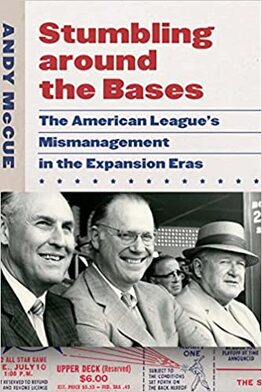
It did not happen often. From 1961, when baseball first expanded, until 1977, when Toronto joined the A.L. with the Seattle Mariners, the junior circuit stunk it up. The National League went 17-2 in All-Star Games (two games were played in 1961 and 1962).
Why, I wondered. I knew why. The National League had talented, exciting players, like Willie Mays, Roberto Clemente, Joe Morgan, Hank Aaron, Bob Gibson and Maury Wills. The N.L. squads had speed, power, pitching and could play defense.
The A.L., on the other hand, played ponderous, station-to-station baseball, relying on the long ball but striking out more than connecting.
Things were more even in the World Series — the A.L. held a 9-8 advantage from 1961 to 1977 — but the league always seemed to lack imagination and overall, the N.L. always seemed to have the edge.
A pure case of mismanagement and missed opportunities.
Andy McCue’s latest book, Stumbling Around the Bases: The American League’s Mismanagement in the Expansion Eras (University of Nebraska Press; $29.95; hardback; 189 pages) shines a light on stark differences between the leagues. While the A.L. dragged its feet with integration and made some poor ownership decisions, the N.L. scooped up big markets and sold plenty of tickets, helped in part by signing Blacks and Latino ballplayers. Overall the N.L. was slow in terms of integration early in the process, but compared to A.L. owners they were sprinters.
As McCue writes in his introduction, the N.L. “was simply better at recognizing their collective interests, at screening their owners, and at recognizing the markets with the better long-term potential.”
 Andy McCue
Andy McCue
The N.L. grabbed markets in Los Angeles and San Francisco, and later, made inroads into the Southwest and South by securing an expansion franchise in Houston and moving the Braves from Milwaukee to Atlanta. The league also placed a franchise in New York to satisfy fans upset by the Dodgers’ and Giants’ exodus and to blunt the formation of the Continental League.
The A.L., meanwhile, allowed Calvin Griffith to move from Washington, D.C., to Minneapolis and stubbornly held on to the idea that baseball could be viable in nation’s capital.
It could not.
The owners also feared congressional action against the game’s antitrust exemption, figuring that politicians unable to watch games in Washington would be angry enough to reexamine the rule and might even look the other way when a third league — like the Continental League pushed by Branch Rickey — challenged the two-league format.
The A.L. would play second fiddle in Los Angeles with the Angels, while allowing the Athletics to move from Kansas City to Oakland. That diluted enthusiasm for baseball in the Bay Area for both leagues and nearly led to the Giants moving to Toronto.
McCue develops these scenarios clearly, demonstrating how the owners were merely members of a cartel that put their interests first. The N.L. was simply better at advancing their goals, which benefited all of its franchises, he writes.
McCue earned the Society for American Baseball Research’s Seymour Medal in 2015 for Mover and Shaker: Walter O’Malley, the Dodgers, and Baseball’s Western Expansion. The 2014 biography of the longtime Dodgers owner was groundbreaking because it pivoted from the emotional baggage carried by heartbroken baseball fans in Brooklyn. It showed O’Malley for what he was — a shrewd businessman who knew how to market the Dodgers in Los Angeles, and a powerful, respected baseball executive who was a major force in the game for three decades.
Accolades aside, McCue’s business background allows him to clearly describe how A.L. owners haphazardly approached expansion — and how O’Malley would outflank them by ensuring that Houston would be in the N.L. fold, opening the vast Texas market to the senior circuit. The A.L. owners, with a chance to grab the Dallas-Fort Worth market, stayed in D.C. and went to Los Angeles even though they had not analyzed the latter market “realistically.”
McCue provides nice biographies of the American League owners, starting with the “Singing Cowboy,” Gene Autry, who “kept his hands off his general managers and managers.” Then there was Charlie Finley, the polar opposite to Autry. Finley, who owned the Athletics and eventually moved the franchise from Kansas City to Oakland and won three World Series with the “Swinging A’s” from 1972 to 1974 despite cantankerous battles with players and managers.
Like another maverick owner, Chicago White Sox owner Bill Veeck, Finley “was simply incapable of playing well with others,” McCue writes. Unlike Veeck, however, Finley “had no modesty and limited social skills.”
Detroit’s John Fetzer was ahead of his time by proposing a nationally televised baseball game on Monday nights, but the networks did not bite. However, the networks wanted the rights to the World Series and the All-Star Games, so Fetzer packaged those with a “Game of the Week” broadcast. But Fetzer’s role in choosing a successor to Ford Frick as baseball commissioner — William D. Eckert — backfired badly.
The A.L. owners were successful businessmen in their own fields, McCue writes. They simply were unable to duplicate that success in baseball.
McCue’s portraits of the 10 A.L. owners give the reader insights into why the junior circuit did not succeed — the owners simply could not row in the same direction.
The second round of expansion in 1969 showed once again that the N.L. still held the upper hand. The N.L. awarded franchises to San Diego and Montreal, while the A.L. set up shop in Kansas City (after the Athletics bolted for Oakland) and Seattle.
The new N.L. cities could draw from a base of 4.1 million people, while the A.L. expansion teams had a population base of 3.1 million, McCue writes.
Ah, Seattle. The Pilots were a franchise that had no direction for a year and are remembered mostly because of Jim Bouton’s 1970 baseball diary, Ball Four.
Sick Stadium was an abysmal park, and Seattle’s mayor and two of the five city council members were opposed to spending money on improvements. But A.L. leaders, “mesmerized by the idea of another West Coast franchise,” overlooked the red flags, McCue writes.
The Soriano brothers, Dewey and Max, were comfortable but not wealthy enough to properly support a major league franchise, so they enlisted outside help, McCue writes. The stadium only drew 15,014 for its opening game and some parts of the facility still needed to be built, even as fans entered the ballpark. It was an omen of things to come.
A.L. leaders had not properly vetted the Pilots’ ownership, so when the Bank of California called in a $3.5 million loan, they were caught flatfooted. The Pilots’ parent company filed for bankruptcy, and as the team headed north from spring training in Arizona, it made a turn to the east and headed for Milwaukee to become the Brewers as a group headed by Bud Selig bought the franchise.
McCue also writes about the addition of George Steinbrenner and Bob Short to the ownership mix. Steinbrenner would set sail on a 37-year stewardship of the Yankees, winning 11 pennants and seven World Series. Short moved the Senators to the Dallas-Fort Worth area, where the team was renamed the Rangers. Short was succeeded several years later in Texas by Brad Corbett, who was “consistently incapable of consistency,” McCue writes.
Eventually the American League went through another round of expansion, bringing baseball back to Seattle and introducing it to Toronto. There would be two more rounds of expansion in the 1990s, with the addition of the Marlins, Rockies, Diamondbacks and Devil Rays (now simply known as the Rays).
Interleague play would arrive in 1997, umpiring staffs were merged and league presidents were phased out. That gave baseball a more streamlined look, with all parts working together, rather than one league pitted against another. Certainly league pride and rivalries remained, but these moves helped homogenize baseball.
Stumbling Around the Bases is only 140 pages of prose, but McCue packs in a great deal of information and insight, armed with his customary attention to detail and deep research. MLB may seem like one big happy family now, but it was not too long ago that there was intense competition.
As McCue points out, the National League won most of those battles. It took the American League decades to catch up.
And, what the heck, the A.L. even regained the lead in the all-time All-Star Game series. The A.L. now owns an 46-43-2 advantage, going 29-14 since 1978 and winning the last eight games. The baseball fan of my youth would be thrilled.
 RSS Feed
RSS Feed
